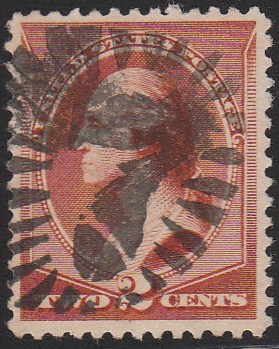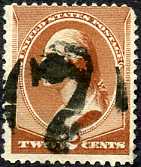(Articles Main) (Home)
Exploring
the Mystery of the Mittineague 7s
by John Valenti
Cancellation
collectors have for years admired the many fine and interesting killers that have
graced covers originating from the town of
I
have always been intrigued by the numeral 7 killers of Mittineague. Several are quite ornately carved. Why this particular number? In the above mentioned article, Roger
Curran mused that this might be the postmaster’s lucky number.2 Just how many varieties of numeral 7
killers exist is not certain.
Whitfield3 illustrates several numeral 7 killers. Five, as of the latest updates,
are attributed to Mittineague.
Three additional unattributed killers are illustrated that bear striking
stylistic similarity to those proven on cover. Off-cover examples of two of these are
pictured in Figure 1.
|
|
|
|
Figure 1 |
|
I
illustrate all eight Whifield tracings with this article. The table provides information for each
regarding attribution and period of use (stamp issue) on which example strikes
have been identified.
|
Whitfield Number |
Attribution |
Stamp Issue |
|
6448 |
Mittineague |
1870 |
|
6449 |
Mittineague |
1870 |
|
6451 |
Mittineague4 |
1870 |
|
6452 |
None5 |
1870 |
|
6453 |
Mittineague6 |
1883 |
|
6456 |
None |
1883 |
|
6457 |
None |
1883 |
|
6459 |
Mittineague4 |
1883 |
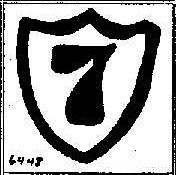
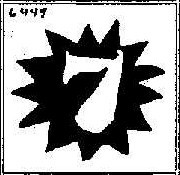
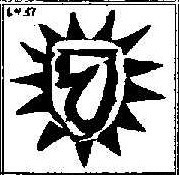
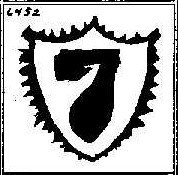
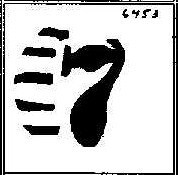
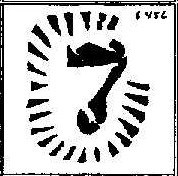
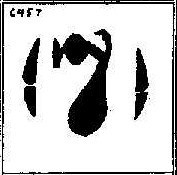
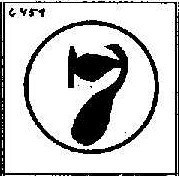
There is a notable stylistic progression to these killers. All eight show a thick vertical stem, fat at the bottom and narrowing toward the top. The stem in 6448 is essentially flat at the bottom, while other 7s show distinct roundness there. There are essential differences between early (1870) 7s and later (1883) ones. The early 7s have a somewhat flat top bar, while the later 7s have a curved top bar that bulges in the middle. In addition, the top of the vertical bar tails above the top bar on latter 7s.
A possible explanation of the Mittineague post office’s fondness for the numeral 7 recently appeared in the form of the cover pictured in Figure 2. This cover is postmarked July 9, 1877 (as verified by the enclosed letter). The killer is a large, bold negative 77, clearly representing the year of the cancellation. This year-date killer is unattributed tracing number 4831 in Whitfield.7 It measures 27 mm across and 20 mm vertically. The right and left sides are rounded while the top and bottom are flattened. There is a distinct separating notch cut between the two 7s at the bottom half of the killer. Each of the 7s has a shape quite similar to the 7 of killer 6448.

Figure 2
I consider this 77 killer to be the original “7”. Although I do not have complete records for recorded dates of use for the attributed killers, I believe that all post-date this 1877 usage. (For example, the 6451 cover pictured in the Fall 2000 NEWS article is struck on a Scott #207, issued in July 1881.) I believe that the Figure 2 killer saw use for only a short time and is rather scarce. I infer this from the lack of previous on-cover reports of this year-date killer. Moreover, this example and the Whitfield tracing suggest no deterioration from use. Perhaps the Mittineague post office created this 77 to celebrate a special event.
I find this 77 esthetically pleasing. It would not surprise me to discover a single negative 7 like these used alone as a killer. Maybe the Mittineague 7s are symbols of luck as has been suggested. But the power and the beauty of this symbol started with the simple intent to celebrate the year of its birth.
The author would appreciate reports of any covers bearing Mittineague 7 killers, indicating Scott number of the stamp on which struck and, especially, full date of use, if available. Please contact the NEWS editor with this information.
1 Curran, Roger, “Cancellations from
2 Ibid., p. 58.
3 Whitfield, Kenneth A., Cancellations Found on 19th Century U.S. Stamps, U.S. Cancellation Club, 2002, pp. 217-8.
4 Pictured on cover in Curran, op. cit., p. 58.
5 The design of 6452 differs from 6448 principally in the addition of serrations to the framing outer shield. Almost assuredly this 7, too, is from Mittineague and is but a modified later instance of the original 6448 killer.
6 UX8 dated December 22, 1885, reported by the author and illustrated in U.S. Cancellation Club NEWS, November 2001, p. 118. The strike on this card demonstrates that the grid drawn in the Whitfield tracing only to the left of the 7 is actually on both sides (image).
7 Whitfield, op. cit., p. 163.
